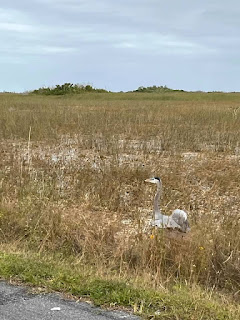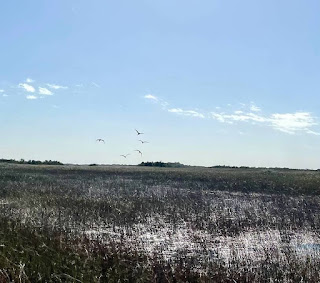The River of Grass: Everglades Shark Valley
I had driven through Alligator Alley (I-75) many times, but had never actually visited Everglades National Park. We decided to take a trip there as part of an early Christmas gift. We chose Shark Valley near Naples, on US 41 and decided to take the 2 hour tram tour on the 15 mile Loop Road.
You will not find any sharks in Shark Valley. It is named after a nearby Shark River, where (as our tour guide said), some early explorers found bull sharks swimming in the river. Today, there are no sharks there in the freshwater river.
As soon as we started our tour, we came across this sign. Right behind it, the red arrow points to our first alligator sighting.
The tour guide educated us on the various ecosystems within the park. When we saw wildlife, the tram slowed down and often stopped so the riders could take photographs. There's a thin red circle around one of the first birds (unidentified) we spotted perched in a tree.
The alligators are often hard to spot as this River of Grass, even in the dry season.
Another bird spotted in the tree. an anhinga.
Snowy egrets look dark against the bright sky.
This is a partially eaten Burmese python that was lying across the road. The guide got out and with a hook, moved it to the side of the road. Vultures had been picking at it and were hovering nearby. The pythons have become a real nuisance in the Everglades, proliferating exponentially and eating many of the smaller wildlife in the area.
There is a yearly competition for capturing pythons in the Everglades, with the winner getting a $10,000 count. Learn more here.
More birdwatching -- an anhinga.
A great blue heron in the sawgrass.
This is a mama gator. She had two little ones with her (you can't see them in this photo).
Another heron.
And another
These turkey vultures were blocking the road, and as we moved slowly, they refused to get out of the way for a couple of minutes.
One more gator. Most of the gators we saw were on the left side of the tram (tip for you).
This is an American crocodile. The guide said there were 3 in the area but this is the only one that had been spotted recently.
We stopped for 15-20 minutes to ascend the viewing tower. It was not a steep walk. This area is the only one with port-o-lets (for those who have the need).
Our guide took pictures of anyone who asked.
Looking down at the water. In the wet season, this area is teeming with gators.
View of the walk to and from the tram.
Nice and shady, although it wasn't hot that day.
And, once again, another heron.
Unidentified birds perched on the top of a tree.
These little water pools are very important to the ecosystem, providing wildlife a water source.
This is the widest spot of the small canal in the park.
Woo hoo -- another gator enjoying the sun.
Cypress trees are one of the ecosystems important to the Everglades.
The sawgrass that catches dew (it's spiky on the top to grab water). Another important part of the Glades is the muck known as periphyton.
To understand the importance this muck, check here.
Another view of the marsh with birds flying over.
Our last gator.
For national park fees and costs of the tram tour, look here.






























0 Comments:
Post a Comment
<< Home